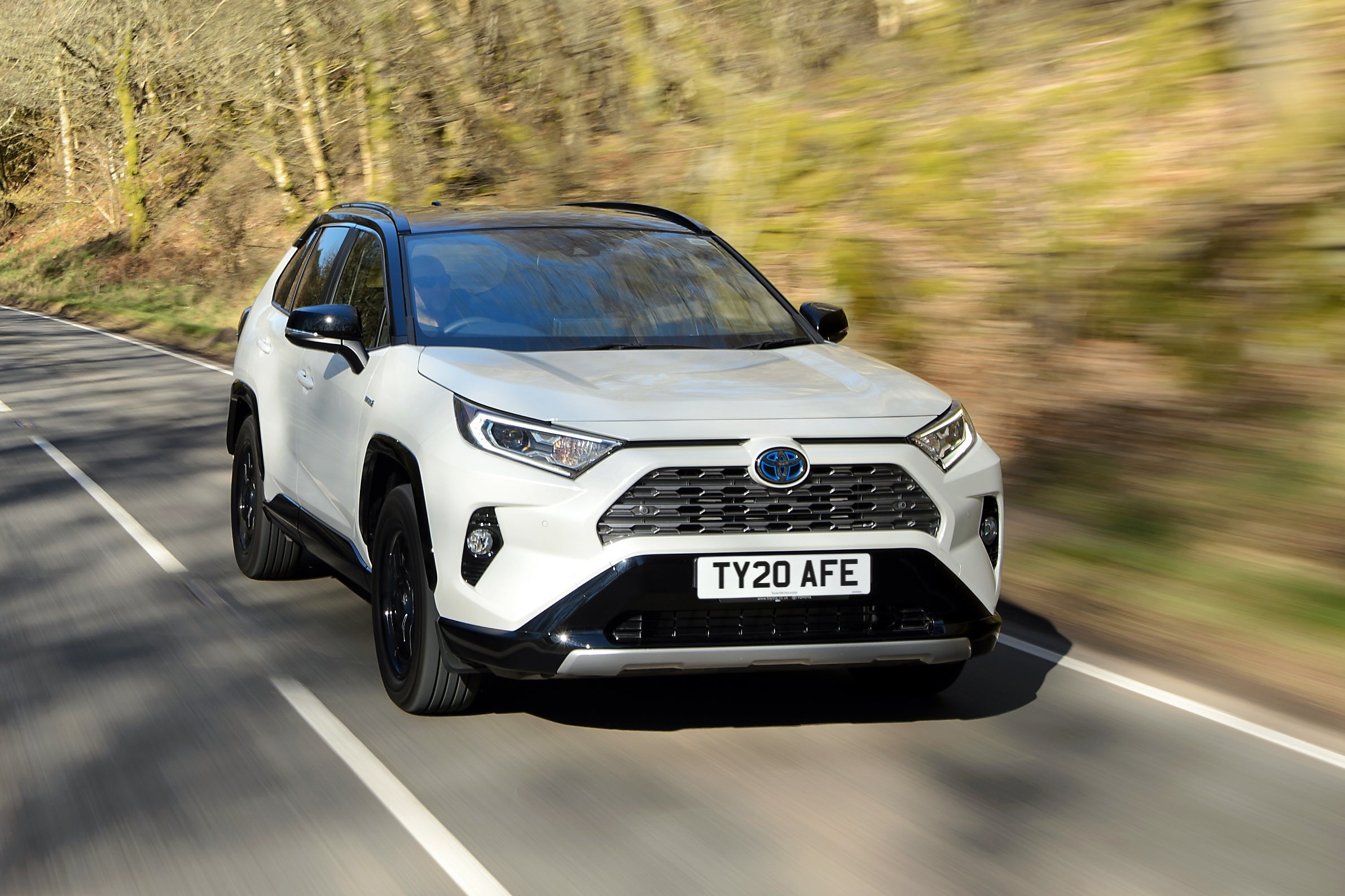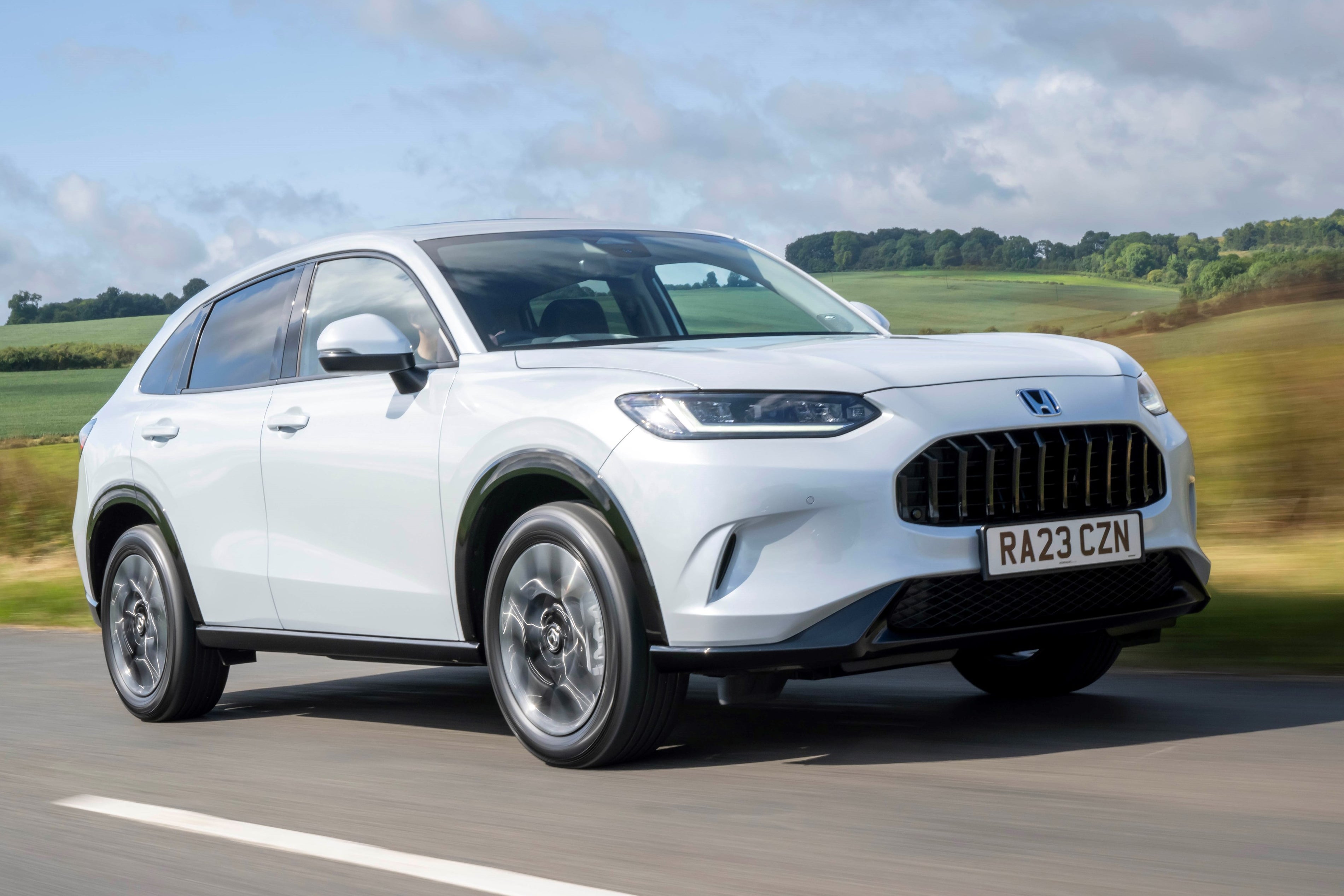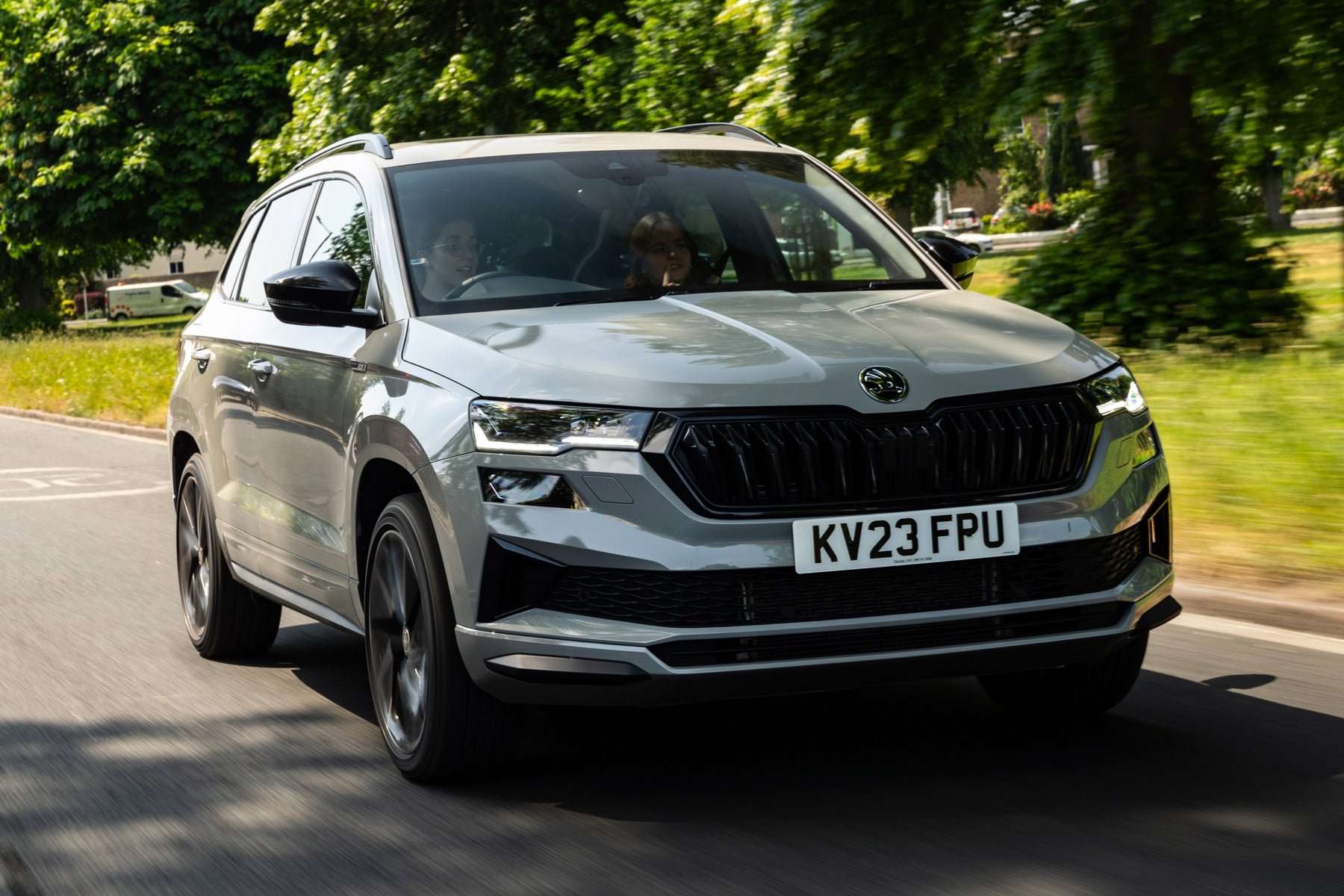Volkswagen Tiguan Review 2024
Written by Ivan Aistrop
Quick overview
Pros
- Smart looks and nice cabin
- Impressively spacious and practical
- Plenty of standard kit
Cons
- Some ergonomic quirks
- Overly complex touchscreen system
- Rather firm ride on large wheels
Overall verdict on the Volkswagen Tiguan
"The latest Mk3 Tiguan is an effective and convincing evolution of what’s gone before it, offering smart looks, a plush interior, lots of space and practicality, and a reasonably polished driving experience."
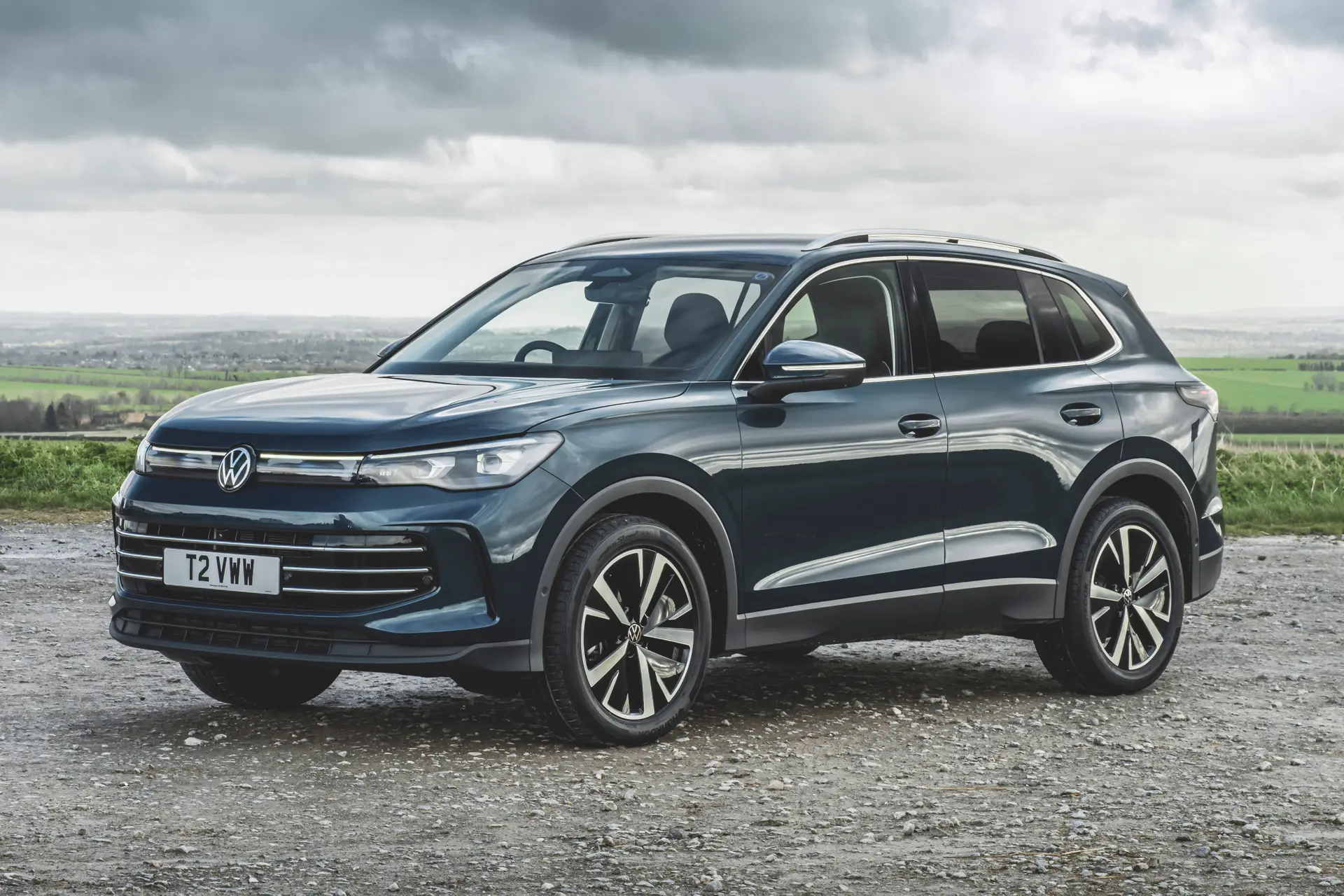
The Tiguan is a very big deal for Volkswagen. Sure, it’s not the brand’s most iconic model, nor its most stylish, nor its most exciting. It is, however, the company’s best-selling model worldwide, so it’s essential to the firm that it gets the latest 2024 version of the VW Tiguan right. Has it? Read our full Volkswagen Tiguan review to find out.
Over recent years, Volkwagen has become a master of not messing too much with a winning formula, and that’s very much the case with the latest third-generation Tiguan: the theme is certainly evolution rather than revolution. Indeed, it’s built on a development of its predecessor’s underpinnings, which allows for more advanced tech to be brought in.
It’s only a smidgen bigger than its predecessor - just 3cm longer - so it occupies a very similar amount of space on the road. However, it’ll be music to the ears of families that the cabin still provides generous space for four lanky occupants, and five will fit at a push. The large boot and clever rear seating arrangement add even more practicality and versatility.
The cabin isn’t without an element of wow-factor, too, with smart, modern design and impressively plush materials. There’s a very decent amount of luxury kit provided throughout the range, too. Large digital screens dominate proceedings on the inside, giving a high-tech feel, helped in no small part by sharp, crisp, and modern graphics. It’s fair to say that the system presents some rather fundamental ergonomic challenges, but more on those later.
Engine options at launch include a pair of 1.5-litre mild-hybrid petrol with either 130PS or 150PS, and unusually, a 150PS 2.0-litre diesel. These are closely followed by a pair of plug-in hybrid options that combine the 1.5 petrol engine with an electric motor and a 19.7kWh battery to produce either 204PS or 272PS. Volkswagen predicts an electric-only range of over 70 miles, and that should result in some very competitive tax bills for company car drivers.
Driving the Tiguan is a similar firm-but-fair experience that existing Tiguan drivers will be used to, but there’s a very decent amount of polish to the way the car goes about its business. And while it’s certainly not the most affordable car of its type, it feels well-rounded and convincing enough to justify its price.
Looking for a used car for sale? We've got 100s of Volkswagen Approved Used Cars for Sale for you to choose from, including a wide range of VW Tiguans for sale. If you're looking for the older version, you need our used Volkswagen Tiguan (2016-2023) review.
Is the Volkswagen Tiguan right for you?
If you need a stylish and practical family car with lots of toys and a reasonably posh-feeling cabin, then the Volkswagen Tiguan is most certainly worth considering. Granted, many mainstream mid-size SUVs with upmarket pretensions do a very similar job, and some do it for appreciably less money than the Volkswagen, but we’d recommend at least test-driving a Tiguan before making your choice.
What’s the best Volkswagen Tiguan model/engine to choose?
So far, we’ve only tried one engine, the higher-powered 150PS version of the entry-level 1.5-litre petrol engine, the eTSI mild hybrid. It’s fine, but we weren’t blown away by it, so the pick of the engine range remains to be seen.
Mid-spec Life or Match are probably the pick of the trim levels. They come with all the essentials while keeping prices reasonable, and they also come with smaller wheels than higher spec cars, which could well benefit the ride.
What other cars are similar to the Volkswagen Tiguan?
Let’s face it, there’s no shortage of mainstream mid-size SUVs with upmarket pretensions, which means there’s no shortage of rivals for the Volkswagen Tiguan. A couple come from within the Volkswagen stable in the shape of the SEAT Ateca and Skoda Karoq, while the Kia Sportage and Hyundai Tucson are also very popular choices in the sector. Honda, meanwhile, will try and tempt you with the latest ZR-V, while the Toyota RAV4, Ford Kuga, Peugeot 3008 and Mazda CX-5 are also interesting options.
Comfort and design: Volkswagen Tiguan interior
"The Tiguan’s cabin is roomy and high in quality, but nevertheless, there are some annoying quirks which could have so easily been avoided."
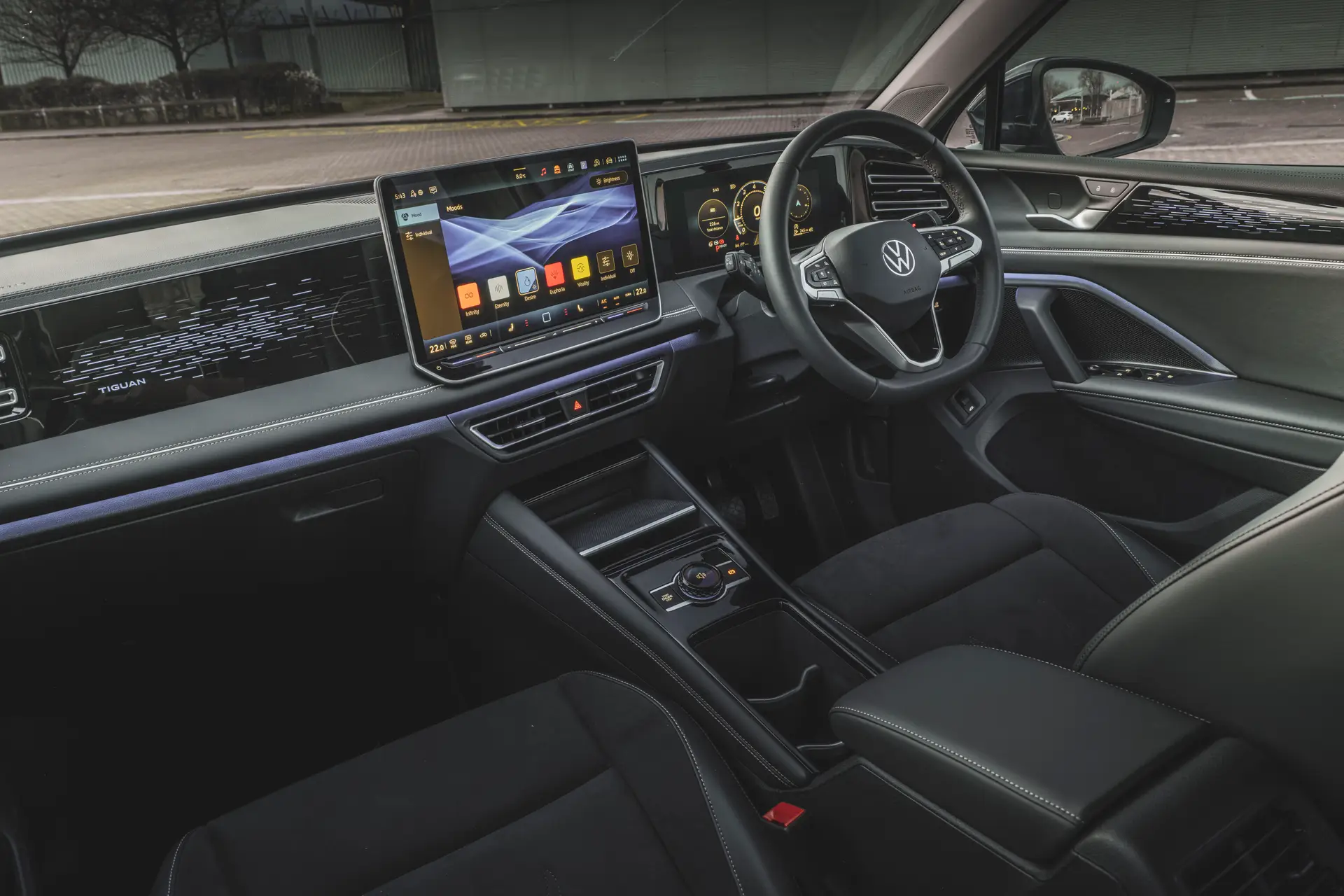
Climb into the driver’s seat of the Tiguan, and you’re immediately struck by the minimalism you’re confronted with. The upright dashboard has very, very little in the way of physical switchgear, and is instead dominated by a pair of large digital screens. We’ll go into more detail about the practicalities of all that in the infotainment section below. We have plenty to say on the matter, not much of it complimentary.
Depending on the trim level you select, you get ever-increasing degrees of ambient lighting and illuminated interior panelling. All in all, the design looks smart and modern. It’s perhaps a little surprising that even high-spec models have manual seat adjustment as standard - you have to raid the options list if you want powered ones - but there’s a good range of adjustment on offer, and all but the entry-level trim have front seats with electric lumbar adjustment. The steering wheel also moves for both rake and reach, but some driver might wish the wheel came a little closer to them.
You get pretty clear visibility in all directions, which helps when parking and manoeuvring, and if you need even more help, front and rear parking sensors, and a reversing camera are standard on all versions, while Elegance and R-Line cars get 360-degree cameras.
The helm of the Tiguan isn’t without its quirks, though. Like most cars, there are a pair of stalks behind the steering wheel, and most drivers will be used to having the indicators on the left one and the wiper controls on the right one. In the Tiguan, however, the right one is now the gear selector for the automatic transmission, and so the left stalk has to take care of everything else. It might take quite a while before you stop putting the car into neutral when you simply meant to clear your windscreen.
Quality and finish
Volkswagen’s products come with a certain expectation of quality, and the Tiguan largely delivers. The large digital screens immediately give a reasonably high-tech feel, while the dashboard and doors feature glossy panels with varying degrees of illumination and ambient lighting depending on which trim level you choose. You’ll also notice stitched leatherette parts and a few metallic trims dotted around, which are nice touches, and help give the cabin an extra feeling of plushness.
A few of the plastics in the lower reaches of the cabin don’t quite have the same lustre of those higher up, but you can say the same of most cars, and they’re not inferior enough to undermine the overall feeling of quality. As far as assembly is concerned, everything feels solid and sturdy, and we experienced no creaks or rattles, although one of the cars we tried did have a slightly ill-fitting glovebox lid.
Infotainment: Touchscreen, USB, sat nav and stereo in the Volkswagen Tiguan
All versions of the Tiguan get the same basic infotainment system as standard, and this comprises a large 12.9-inch central infotainment touchscreen, plus a 10.25-inch digital instrument panel behind the steering wheel that Volkswagen calls Digital Cockpit Pro. On the base-level Tiguan, you also get two USB-C charging ports up front, eight speakers, Bluetooth, DAB, and wireless app connect, which basically amounts to Apple CarPlay and Android Auto. Upgrade to Life trim or above, and you also get navigation, wireless smartphone charging and AI-powered voice control.
If you want an even glitzier system, a massive 15.0-inch central screen is available on the options list.
Whatever the size of your screen, the system looks pretty glitzy. The graphics look sharp and modern, while the screen transitions and animations are slick. The screen has good sensitivity, too.
However, that doesn’t stop the system being something of an ergonomic mess, unfortunately. As is the fashion these days, Volkswagen has sought to purge physical switchgear from the Tiguan’s cabin as far as possible, and there’s hardly any left. That means almost every function - other than changing the media volume, selecting a driving mode or operating the hazard lights (having a physical button for that last one is a legal requirement, which we suspect is the only reason it survived the cull) - must be operated through the touchscreen.
Inevitably, this is way more distracting to operate on the move than physical buttons and dials are, and because the system is so complex, the screen looks cluttered and confusing despite its generous size. The seemingly endless menus and submenus are illogically laid out, and many are signified by ambiguously-designed icons. All, in all, it’s hopelessly easy to get lost, even when trying to perform the most basic of functions.
And here’s the extra sting in the tail. As you’re trundling along the road, squinting at the screen in bewilderment, trying in vain to find and operate the function you’re looking for, the driver attention system picks up that you’ve been gawping at the screen for too long instead of looking at the road, and your car then promptly tells you off. This may well be the first time we’ve ever described a car as being hypocritical.
Space and practicality: Volkswagen Tiguan boot space
SUVs of this size and type are usually used as family cars, and happily, the Tiguan has easily enough space to cope with such use. The latest iteration is an ever so slightly bigger car than the one it replaced, being 4,539mm long, 1,660mm tall and 1,842mm wide (without door mirrors).
At the same time, the wheelbase (the distance between the front- and rear wheels) remains unchanged, but there’s still a very good amount of legroom on offer. Set up the front seats up for occupants of six-foot-plus, and there’s still easily enough room behind for folk of a similar size to sit in the rear seats with no danger of their knees touching the seat in front. Headroom is very generous, too, so a pair of tall adults will be very comfortable in the back, and the rear-seat backrests can be reclined, too. Things will be a bit more cramped if you try and squeeze in a third passenger, but importantly, everyone will fit. Whoever winds up in the middle has a reasonably wide pew to sit on, too, although they will have to straddle a very bulky transmission tunnel.
Getting in and out of the rear seats is slightly annoying, however. The rearmost edges of the rear door openings have a small strip of protruding bodywork that gets in your way when climbing in and out. You’ll either have to curve yourself awkwardly around it, or you’ll bash your hip on it.
Happily, space is very generous in the boot. Most versions provide a whopping 652 litres of loadspace, but that does drop to 490 litres in the plug-in hybrid versions. The cars we tried had a false floor with a huge storage area underneath, and this floor reduces the severity of the lip at the entrance of the boot. And, when you fold down the 40-20-40 split-folding rear seats down - which can be done by either pulling catches in the boot or pulling tapes in the seat itself - the false floor also levels off the step up to the folded rear seatbacks. These don’t lay quite flat, though, so there is a gentle slope in the extended load area.
Handling and ride quality: What is the Volkswagen Tiguan like to drive?
"The cars we’ve driven so far have a rather firm ride, but that might well be partly due to the large alloy wheels fitted. Things may well be smoother on smaller rims."
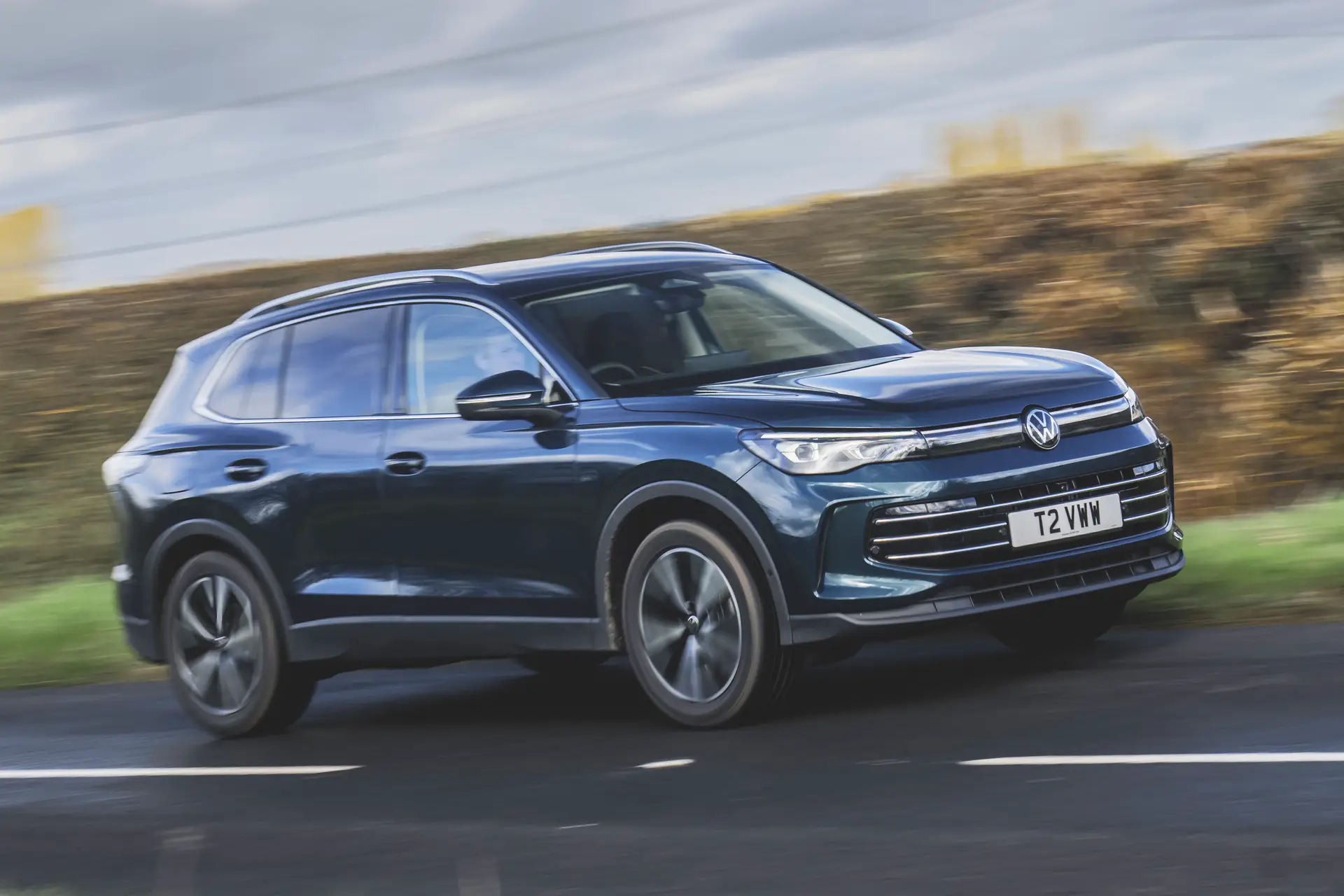
We’ve driven the Tiguan in a couple of different forms, and there are some interesting variations in their behaviour. The first we drove was a high-spec Elegance-trimmed car, which comes on large 19-inch alloy wheels. The size of the rims might account for why the right felt decidedly firm: there was a slightly jittery and unsettled feeling for quite a large amount of the time, and larger cracks and potholes in the road surface resulted in rather large thuds making their way through to the cabin. Comfort levels weren’t unacceptable by any stretch, but we could name several rival cars that ride more comfortably. We’d be interested to try a lower-spec car on smaller wheels to see if that feels a bit more forgiving.
The second car we drove was an R-Line, which comes on potentially-even-more-problematic 20-inch wheels. However, this car was fitted with the optional Dynamic Chassis Control adaptive suspension system. This alters the firmness of its dampers according to which of the various driving modes you select. In truth, switching between Sport and Comfort modes reveals a very small variation in ride stiffness - you’ll have to really concentrate to detect it at all - but regardless of the mode, the more sophisticated suspension did take a little of the edge off the ride compared to the Elegance-trimmed car on its standard passive suspension. We’re not sure it’s enough of an improvement to justify the four-figure sum you pay for the optional suspension, however: it may well transpire that smaller wheels have even more of a beneficial effect.
Regardless of the suspension fitted, the Tiguan’s handling is pretty good, with plenty of grip and traction despite the fact that all versions are front-wheel drive rather than four-wheel drive. Body movements are kept in check reasonably well and the steering is quick and responsive, but without feeling too twitchy, so the car changes direction eagerly and tidily.
What engines and gearboxes are available in the Volkswagen Tiguan?
The Tiguan is offered with a variety of powertrains, all equipped with an automatic gearbox. The range starts with two 1.5-litre mild-hybrid four-cylinder turbo petrol engines, badged as eTSI. These come with either 130PS or 150PS, with the former performing the 0-62mph dash in 10.6 seconds, and the latter cutting that to 9.1 seconds.
A 2.0-litre turbodiesel is also offered, which gives 150PS and does the 0-62mph sprint in 9.4 seconds. The range is rounded off by a pair of plug-in hybrids - badged eHybrid - that combine the 1.5-litre petrol engine with an electric motor and a six-speed automatic gearbox (it’s a seven-speedeer in the others) to develop either 204PS or 272PS. The former has a 0-62mph time of 8.2 seconds, the latter a time of 7.2 seconds.
So far, the only engine we’ve had the opportunity to try is the more powerful of the two eTSI mild hybrids, and it doesn’t feel as punchy as you might expect. The level of performance you get is just about adequate provided you’re not in too much of a hurry, but you often feel the engine having to work surprisingly hard to haul the car along at even a moderate rate. And when you ask for stronger acceleration, the revs climb even further, but there’s a disproportionately small increase in the rate of forward motion.
Refinement and noise levels
As we just said, the only engine we’ve tried - the 150PS eTSI mild hybrid - has to work itself pretty hard to maintain even a moderate pace. It’s not a noisy engine, and you don’t feel too much in the way of vibration from it, so it’s not an unpleasant experience, but it is noticeable nonetheless. Wind noise and road noise are reasonably well contained, so the Tiguan is a reasonably hushed car to cruise along the motorway in.
Safety equipment: How safe is the Volkswagen Tiguan?
The precise amount of safety kit you get in your Tiguan depends on the trim level you go for. All versions get a collection of airbags, plus driver assistance features including a driver drowsiness/attention monitor, autonomous emergency braking with pedestrian and cyclist monitoring, lane keep assist, a lane-change system, front and rear cross traffic assist, dynamic road sign display, front and rear parking sensors, and a reversing camera.
Life trim adds adaptive cruise control to the roster, while Match versions have cleverer headlights and cleverer parking assistance system. Elegance trim brings more functionality to the adaptive cruise control for increased level of autonomous driving, plus 360-degree cameras for a better view around you when parking.
This roster of kit is likely to see the Tiguan do well in Euro NCAP crash tests, but those haven’t taken place just yet.
MPG and fuel costs: What does a Volkswagen Tiguan cost to run?
"There’s a broad choice of powertrain options available in the Tiguan, including diesel, mild-hybrid petrol, and full plug-in hybrids."
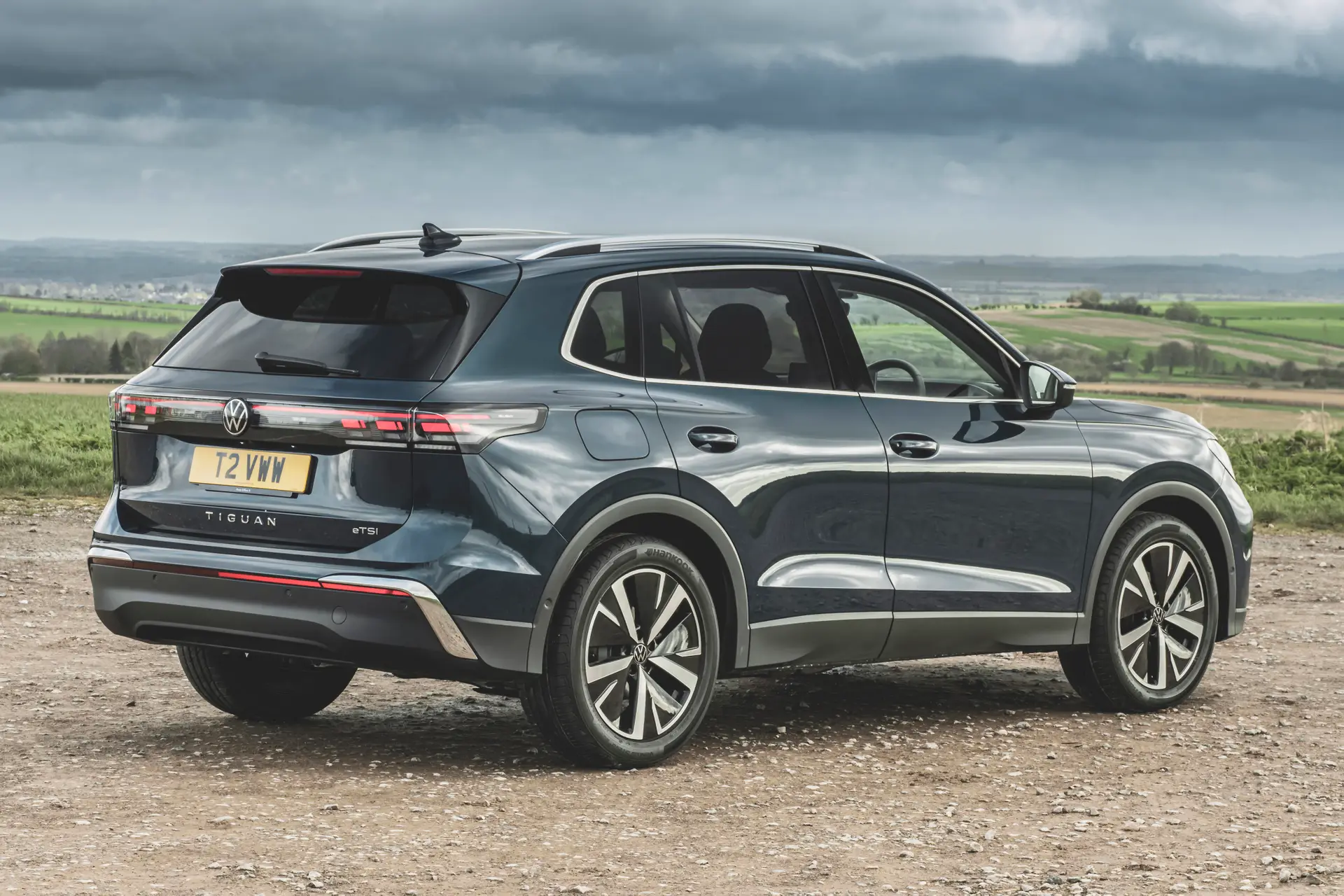
The two eTSI mild hybrid petrol engines have official WLTP fuel economy figures of 46.3mpg in 130PS guise and 45.6mpg in 150PS form. The diesel - it remains to be seen how well that sells what with modern attitudes to that fuel type - clocks an official figure of 52.3mpg, and could well still be the most desirable option for those who do lots of motorway miles.
The official figures indicate that the two plug-in eHybrid models are the superstars of the range on fuel economy, with WLTP test resulting in totals of 706.2mpg for the 204PS version, and a comparatively ‘paltry’ 565.0mpg on the more powerful 272PS iteration. However, this includes the car’s all-electric range - which Volkswagen estimates at approximately 70 miles - and including this range in the official figure is what skews the official tests to look overly flattering where plug-in hybrids are concerned. Bank on getting far less than the official numbers in the real world, and for best results, make sure you keep your car charged up with electricity and limit yourself exclusively to short journeys.
How reliable is a Volkswagen Tiguan?
Volkswagen’s reputation for reliability has been somewhat overstated over the years, and it may not necessarily be justified. For instance, the brand was named as the fourth least reliable manufacturer of the 29 to feature in the latest HonestJohn.co.uk Satisfaction Index, which is a worry.
However, it was mainly older models like the Polo and previous Golf that brought the brand’s average score down, and the previous Tiguan was actually singled out for praise by owners for its dependability and quality. Of course, the latest iteration is based on heavily revised architecture, so you can only read a certain amount into the performance of the previous Tiguan, but it should hopefully provide buyers with some confidence.
Insurance groups and costs
Insurance groupings for the Tiguan start at group 18 for the 130PS version of the 1.5-litre eTSI mild hybrid, regardless of trim. Upgrading to the 150PS version will raise your insurance grouping to 21 or 22 depending on the trim level you choose, while going for the diesel will place your car in group 22 or 23.
Choosing the less powerful of the two plug-in hybrids means you’ll be paying either a group 27 or group 28 premium, while the range-topping 272PS version sits in group 31.
VED car tax: What is the annual road tax on a Volkswagen Tiguan?
Since 2017, all petrol and diesel cars have been taxed at the same flat rate, that rate currently standing at £190 per year. All Tiguans except the diesel are either mild hybrids or plug-in hybrids, though, and that means they qualify for a discount of a princely £10. Whoop-de-do.
Also, beware of the luxury car surcharge for all cars that cost over £40,000 when new, including optional extras. Some Tiguans sit below that threshold, but many sit above. Those that sit above will be liable for an additional charge of £390 per year for a five-year period between years two and six of the car’s life.
How much should you be paying for a used Volkswagen Tiguan?
"As a brand new car - which the Tiguan currently is - prices start at around £34,000 for a car with the most basic trim level and engine."
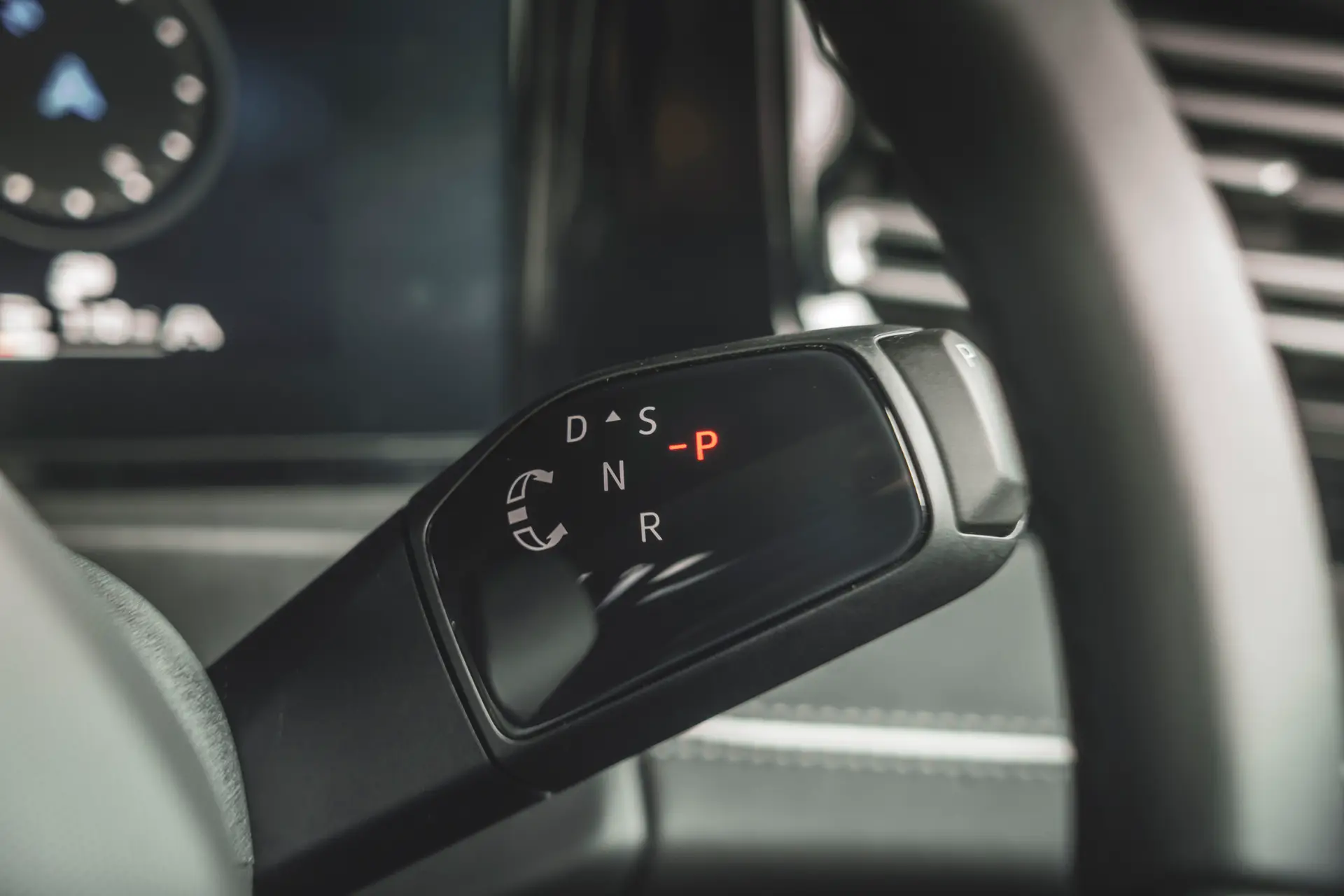
And, as a brand new car, the used car market isn’t exactly awash with used examples just yet. However, the Tiguan is Volkswagen’s best-selling car globally, and does rather well on these shores, too, and its popularity should mean that it won’t be long until some tempting used examples become available.
Look out for cars that have been pre-registered by dealers to meet sales targets, as these can be a great way of getting an as-new car for a hefty four-figure saving. Sure, you won’t get to spec the car yourself, but you won’t have to wait for it to be built and shipped, either.
Trim levels and standard equipment
The Tiguan range starts with the standard trim known simply as Tiguan, and this comes with 17-inch alloy wheels, climate control air-conditioning, a leather-wrapped steering wheel with gearshift paddles, cloth upholstery, front- and rear parking sensors, a reversing camera, black roof rails and all-round LED lighting. That’s on top of all the infotainment and safety equipment we spoke about earlier.
Upgrading to the Life trim level earns you 18-inch wheels, ambient interior lighting, power adjustable lumbar support for the front seats, and three-zone climate control with controls in the rear. Match trim adds powered tailgate operation, keyless entry, more intricate ambient lighting, a light strip between the headlights and silver roof rails. Elegance cars look even posher with 19-inch wheels and additional exterior styling pieces, plus you also get 360-degree cameras and heated front seats with massaging function.
The range-topping R-Line trim is mostly about added visual appeal, with 20-inch wheels, extra styling touches inside and out, even posher ambient lighting, and sports seats.
Ask the heycar experts: common questions
Is the Volkswagen Tiguan a good car?
Is the Volkswagen Tiguan an SUV?
Is the Volkswagen Tiguan a hybrid?
Volkswagen Tiguan cars for sale on heycar
- 1.5 TSI 150 R-Line 5dr DSG
Volkswagen Tiguan
202030,945 milesPetrolor £26,787was
£27,495
£708 offgreat priceNG27JB - 1.5 TSI Active 5dr
Volkswagen Tiguan
202117,000 milesPetrol£22,110£386 mogreat priceDL11XP - 1.5 TSi EVO 150 Match 5dr
Volkswagen Tiguan
201914,165 milesPetrol£19,680£300 mofair priceLS118TU - 1.5 TSI 150 Elegance 5dr DSG
Volkswagen Tiguan
202132,687 milesPetrol£25,968£423 mogood priceLN2 4HW - 2.0 TDi 150 R-Line 5dr DSG
Volkswagen Tiguan
201840,140 milesDiesel£612 moor £21,944was
£23,097
£1,153 offgood priceDE214XF
Similar Models
Stay up to speed with great offers plus the latest car news and reviews
Keep me updated by email with the latest advice, news and offers from heycar.
By submitting you agree to our privacy policy

